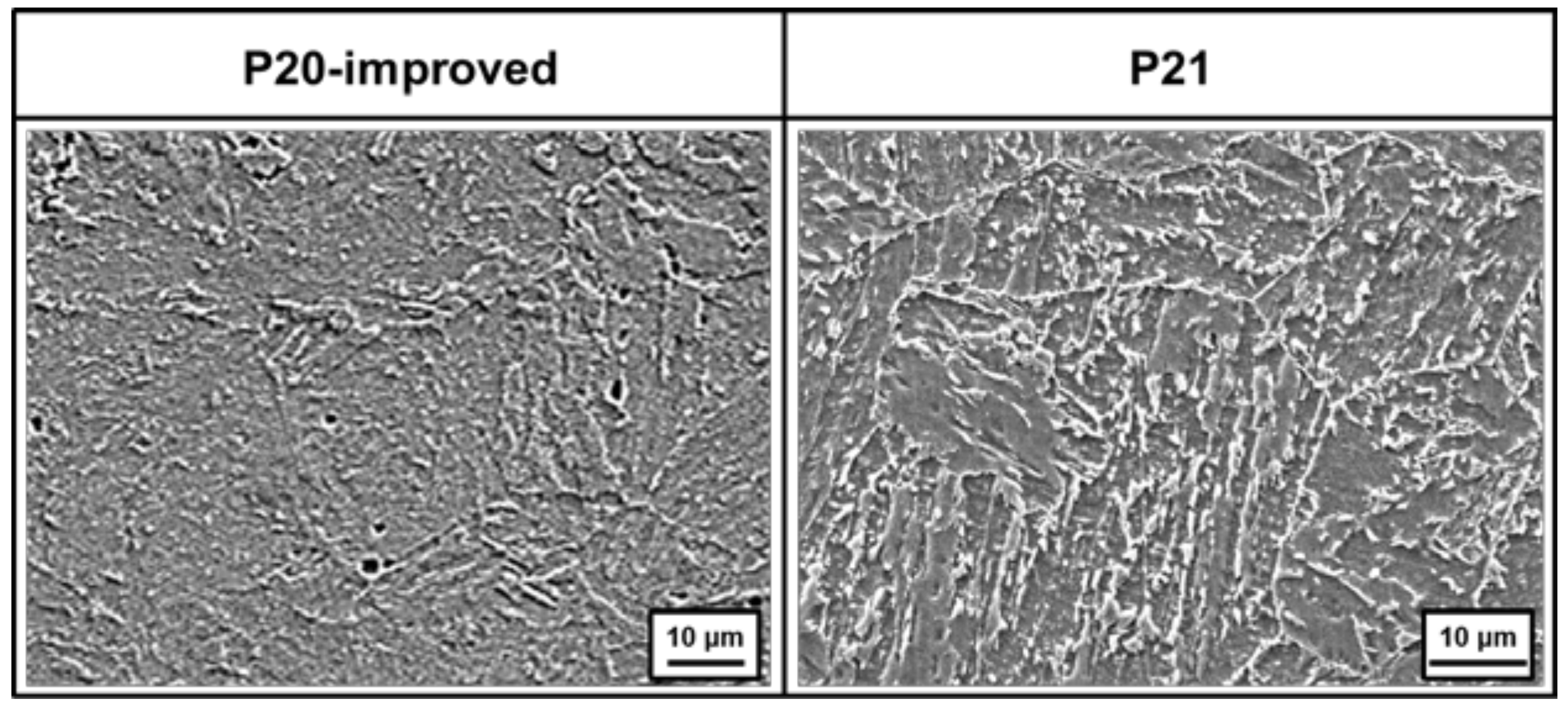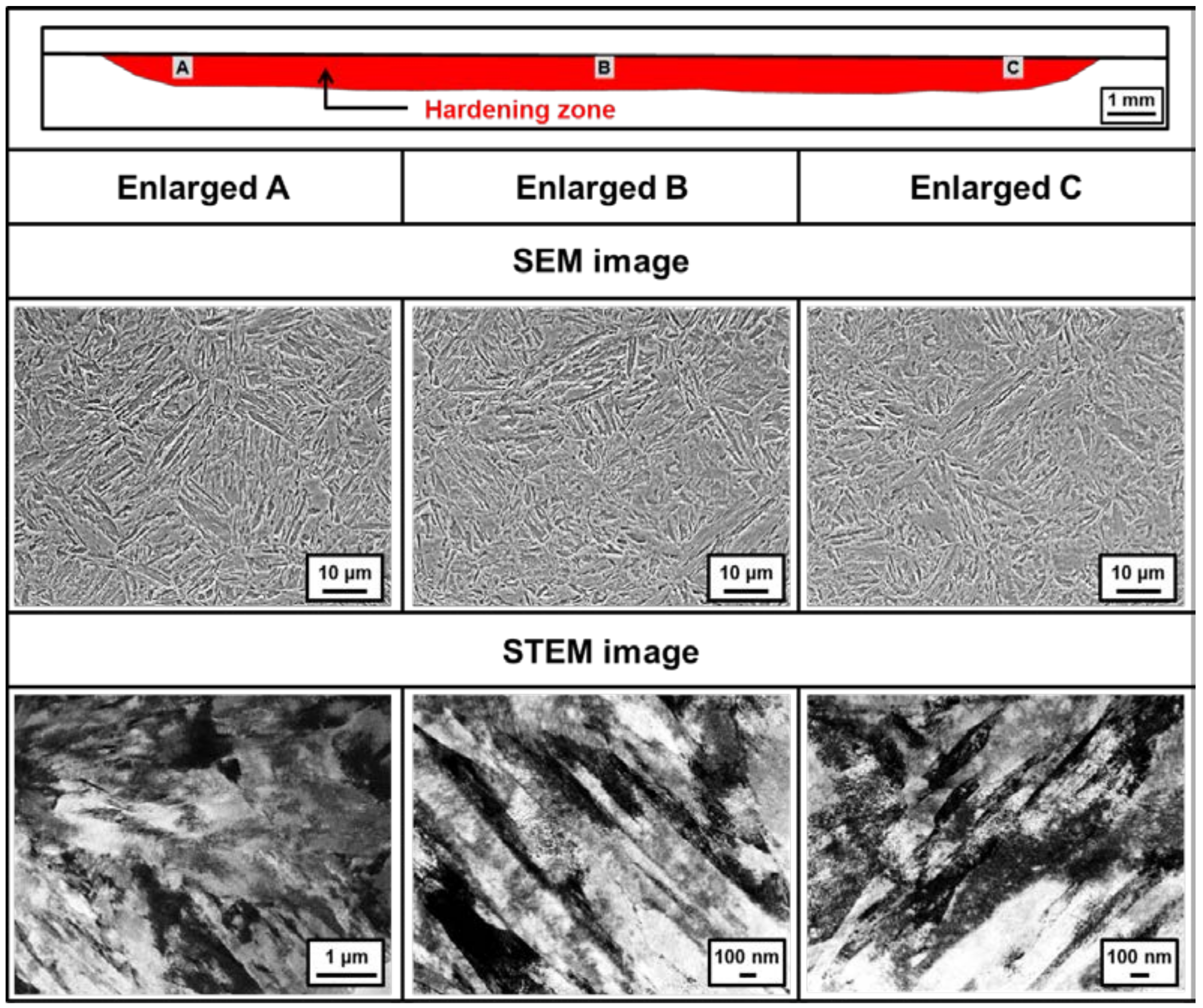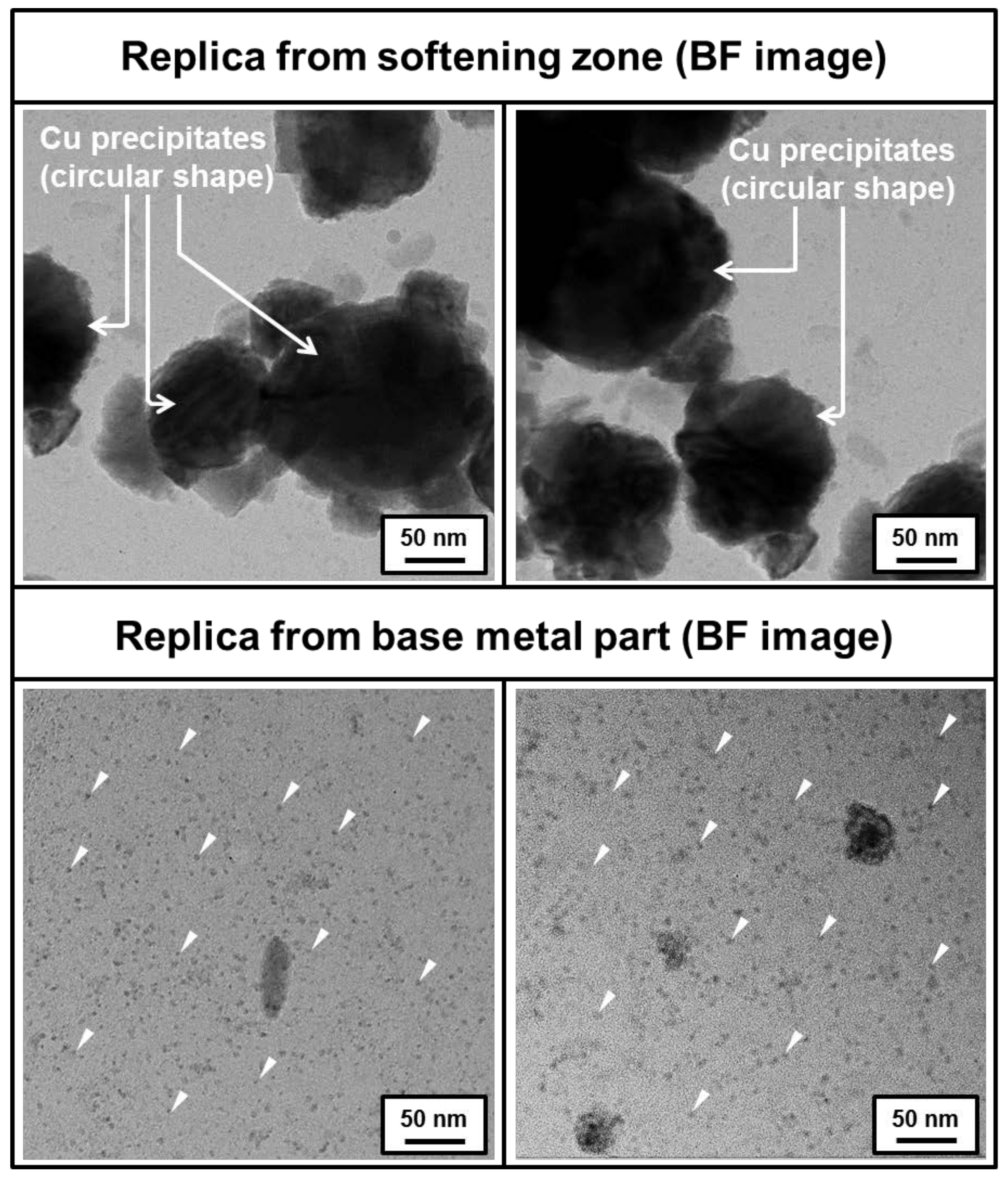Microstructural Characterization of Surface Softening Behavior for Cu-Bearing Martensitic Steels after Laser Surface Heat Treatment
Abstract
:1. Introduction
2. Materials and Experimental Procedures
2.1. Materials
2.2. Experimental Procedures
3. Results and Discussion
3.1. Microstructure of Base Metals (As-Recieved)
3.2. Determining Heat Treatment Conditions from Thermodynamic Calculations
3.3. Laser Power and Surface Temperature during Laser-Assisted Heat Treatment
3.4. Cross-Sectional Macrostructure Variations with Temperature
3.5. Hardening and Softening Behavior after Laser-Assisted Heat Treatment
3.6. Microstructural Characterization of the Hardening Zone in P20-Improved Steel
3.7. Relationship between Coarsening of Cu Precipitates and Formation of the Softening Zone in P21 Steel
4. Conclusions
Author Contributions
Funding
Acknowledgments
Conflicts of Interest
References
- Shiou, F.J.; Cheng, C.H. Ultra-precision surface finish of NAK80 mould tool steel using sequential ball burnishing and ball polishing processes. J. Mater. Process. Technol. 2018, 201, 554–559. [Google Scholar] [CrossRef]
- Singh, G.; Verma, A. A brief review on injection moulding manufacturing process. Mater. Today-Proc. 2017, 4, 1423–1433. [Google Scholar] [CrossRef]
- Silva, F.J.G.; Martinho, R.P.; Alexandre, R.J.D.; Baptista, A.P.M. Increasing the wear resistance of molds for injection of glass fiber reinforced plastics. Wear 2011, 271, 2494–2499. [Google Scholar] [CrossRef] [Green Version]
- Boztepe, E.; Alvesb, A.C.; Ariza, E.; Rocha, L.A.; Cansever, N.; Toptan, F. A comparative investigation of the corrosion and tribocorrosion behavior of nitrocarburized, gas nitrided, fluidized-bed nitrided, and plasma nitride plastic mould steel. Surf. Coat. Technol. 2018, 334, 116–123. [Google Scholar] [CrossRef]
- Wen, D.C. Microstructure and corrosion resistance of the layers formed on the surface of precipitation hardenable plastic mold steel by plasma-nitriding. Appl. Surf. Sci. 2009, 256, 797–804. [Google Scholar] [CrossRef]
- Chun, E.J.; Nishimoto, K.; Saida, K. Evaluation of solidification cracking susceptibility in laser welds for type 316FR stainless steel. Weld. World 2016, 60, 217–231. [Google Scholar] [CrossRef]
- Chun, E.J.; Lee, S.J.; Suh, J.; Kang, N.; Saida, K. Solidification cracking behavior in austenitic stainless steel laser welds (part 1)—Evaluation of solidification cracking susceptibility by laser beam welding Varestraint test. J. Weld. Join. 2016, 34, 54–60. [Google Scholar] [CrossRef]
- Chun, E.J.; Lee, S.J.; Suh, J.; Kang, N.; Saida, K. Solidification cracking behavior in austenitic stainless steel laser welds (part 2)—Effects of δ–ferrite crystallization and solidification segregation behavior on solidification cracking susceptibility. J. Weld. Join. 2016, 34, 61–69. [Google Scholar] [CrossRef]
- Zhang, Z.; Yu, T.; Kovacevic, R. Erosion and corrosion resistance of laser cladded AISI 420 stainless steel reinforced with VC. Appl. Surf. Sci. 2017, 410, 225–240. [Google Scholar] [CrossRef]
- Cong, D.; Zhou, H.; Ren, Z.; Zhang, H.; Ren, L.; Meng, C.; Wang, C. Thermal fatigue resistance of hot work die steel repaired by partial laser surface remelting and alloying process. Opt. Lasers Eng. 2014, 54, 55–61. [Google Scholar] [CrossRef]
- Tong, X.; Dai, M.J.; Zhang, Z.H. Thermal fatigue resistance of H13 steel treated by selective laser surface melting and CrNi alloying. Appl. Surf. Sci. 2013, 217, 373–380. [Google Scholar] [CrossRef]
- Sun, P.; Li, S.; Yu, G.; He, X.; Zheng, C.; Ning, W. Laser surface hardening of 42CrMo cast steel for obtaining a wide and uniform hardened layer by shaped beams. Int. J. Adv. Manuf. Technol. 2014, 70, 787–796. [Google Scholar] [CrossRef]
- Wang, C.; Zhou, H.; Liang, N.; Wang, C.; Cong, D.; Meng, C.; Ren, L. Mechanical properties of several laser remelting processed steels with different unit spacings. Appl. Surf. Sci. 2014, 313, 333–340. [Google Scholar] [CrossRef]
- Lee, K.H.; Choi, S.W.; Yoon, T.J.; Kang, C.Y. Microstructure and hardness of surface melting hardened zone of mold steel, SM45C using Yb:YAG disk laser. J. Weld. Join. 2016, 34, 75–81. [Google Scholar] [CrossRef]
- Hongchao, Q. Experimental investigation of laser peening on Ti17 titanium alloy for rotor blade applications. Appl. Surf. Sci. 2015, 351, 524–530. [Google Scholar] [CrossRef]
- Hoppius, J.S.; Kukreja, L.M.; Knyazeva, M.; Pohl, F.; Walther, F.; Ostendorf, A.; Gurevich, E.L. On femtosecond laser shock peening of stainless steel AISI 316. Appl. Surf. Sci. 2018, 435, 1120–1124. [Google Scholar] [CrossRef] [Green Version]
- Haque, R. Quality of self-piercing riveting (SPR) joints from cross-sectional perspective: A review. Arch. Civ. Mech. Eng. 2018, 18, 83–93. [Google Scholar] [CrossRef]
- Chun, E.J.; Kim, M.S.; Nishikawa, H.; Park, C.; Suh, J. Laser-assisted selective fusing of thermal sprayed Ni-based self-fluxing alloys by using high–power diode lasers. Opt. Lasers Technol. 2018, 100, 317–324. [Google Scholar] [CrossRef]
- Syed, B.; Shariff, S.M.; Padmanabham, G.; Lenka, S.; Bhattacharya, B.; Kundu, S. Influence of laser surface hardened layer on mechanical properties of re-engineered low carbon steel sheet. Mat. Sci. Eng. A 2017, 685, 168–177. [Google Scholar] [CrossRef]
- Guarino, S.; Barletta, M.; Afilal, A. High power diode laser (HPDL) surface hardening of low carbon steel: Fatigue life improvement analysis. J. Manuf. Process. 2017, 28, 266–271. [Google Scholar] [CrossRef]
- Telasang, G.; Majumdar, J.D.; Padmanabham, G.; Manna, I. Wear and corrosion behavior of laser surface engineered AISI H13 hot working tool steel. Surf. Coat. Technol. 2015, 261, 69–78. [Google Scholar] [CrossRef]
- Telasang, G.; Majumdar, J.D.; Padmanabham, G.; Manna, I. Structure-property correlation in laser surface treated AISI H13 tool steel for improved mechanical properties. Mat. Sci. Eng. A 2014, 599, 255–267. [Google Scholar] [CrossRef]
- Shariff, S.M.; Pal, T.K.; Padmanabham, G.; Joshi, S.V. Influence of chemical composition and prior microstructure on diode laser hardening of railroad steels. Surf. Coat. Technol. 2013, 228, 14–26. [Google Scholar] [CrossRef]
- Santhanakrishnan, S.; Kovacevic, R. Hardness prediction in multi-pass direct diode laser heat treatment by on-line surface temperature monitoring. J. Mater. Process. Technol. 2012, 212, 2261–2271. [Google Scholar] [CrossRef]
- Li, R.; Jin, Y.; Li, Z.; Qi, K. A Comparative study of high-power diode laser and CO2 laser surface hardening of AISI 1045 steel. J. Mater. Eng. Perform. 2014, 23, 3085–3091. [Google Scholar] [CrossRef]
- Soriano, C.; Leunda, J.; Lambarri, J.; Navas, V.G.; Sanz, C. Effect of laser surface hardening on the microstructure, hardness and residual stressed of austempered ductile iron grades. Appl. Surf. Sci. 2011, 257, 7101–7106. [Google Scholar] [CrossRef]
- Järvenpää, A.; Jaskari, M.; Hietala, M.; Mäntyjärvi, K. Local laser heat treatments of steel sheets. Phys. Proc. 2015, 78, 296–304. [Google Scholar] [CrossRef]
- Qiu, F.; Uusitalo, J.; Kujanpaa, V. Laser transformation hardening of carbon steel: Microhardness analysis on microstructural phases. Surf. Eng. 2013, 29, 34–40. [Google Scholar] [CrossRef]
- Farshidianfar, M.H.; Khajepouhor, A.; Gerlich, A. Real time monitoring and prediction of martensite formation and hardening depth during laser heat treatment. Surf. Coat. Technol. 2017, 315, 326–334. [Google Scholar] [CrossRef]
- Hsiao, C.N.; Yang, J.R. Age hardening in martensitic/bainitic matrices in a copper-bearing steel. Mater. Trans. 2000, 41, 1312–1321. [Google Scholar] [CrossRef]
- Jung, J.G.; Jung, M.; Kang, S.; Lee, Y.K. Precipitation behaviors of carbides and Cu during continuous heating for tempering in Cu-bearing medium C martensitic steel. J. Mater. Sci. 2014, 49, 2204–2212. [Google Scholar] [CrossRef]
- Yao, C.; Xu, B.; Huang, J.; Zhang, P.; Wu, Y. Study on the softening in overlapping zone by laser-overlapping scanning surface hardening for carbon and alloyed steel. Opt. Laser Eng. 2010, 48, 20–26. [Google Scholar] [CrossRef]
- Bouquet, J.; Camp, D.V.; Malek, O.; Haaf, P.T.; Vanmeensel, K.; Lauwers, B. Aiming for improved lifetime of die and mold components through an integrated laser hardening operation, combining machining and a selective heat treatment in one setup. Proc. CIRP 2016, 46, 541–544. [Google Scholar] [CrossRef]
- Kwok, C.T.; Leong, K.I.; Cheng, F.T.; Man, H.C. Microstructural and corrosion characteristics of laser surface-melted plastics mold steels. Mater. Sci. Eng. A 2003, 357, 93–103. [Google Scholar] [CrossRef]

















| Materials | C | Ni | Si | Mn | Cr | Mo | Cu | Fe |
|---|---|---|---|---|---|---|---|---|
| AISI P20 improved | 0.38 | 0.12 | 0.26 | 1.02 | 1.72 | 0.46 | - | Bal. |
| AISI P21 | 0.15 | 3.00 | 0.30 | 1.60 | 0.30 | 0.30 | 1.03 | Bal. |
| Parameters | Values |
|---|---|
| Oscillator | 4 kW direct diode laser |
| Wavelength of laser beam (nm) | 970 |
| Beam dimension (mm) | 24 × 1 |
| Maximum laser power density (W/cm2) | 2.5 × 103 |
| Direction of beam irradiation | 5° tilting from normal direction of specimen |
| Focal length (mm) | 310 |
| Defocus distance (mm) | 0 |
| Scan speed of laser beam (mm/s) | 5 |
| Temperature of heat treatment (K) | 1073–1473 |
© 2018 by the authors. Licensee MDPI, Basel, Switzerland. This article is an open access article distributed under the terms and conditions of the Creative Commons Attribution (CC BY) license (http://creativecommons.org/licenses/by/4.0/).
Share and Cite
Chun, E.-J.; Sim, A.; Kim, M.-S.; Kang, N. Microstructural Characterization of Surface Softening Behavior for Cu-Bearing Martensitic Steels after Laser Surface Heat Treatment. Metals 2018, 8, 470. https://doi.org/10.3390/met8060470
Chun E-J, Sim A, Kim M-S, Kang N. Microstructural Characterization of Surface Softening Behavior for Cu-Bearing Martensitic Steels after Laser Surface Heat Treatment. Metals. 2018; 8(6):470. https://doi.org/10.3390/met8060470
Chicago/Turabian StyleChun, Eun-Joon, Ahjin Sim, Min-Su Kim, and Namhyun Kang. 2018. "Microstructural Characterization of Surface Softening Behavior for Cu-Bearing Martensitic Steels after Laser Surface Heat Treatment" Metals 8, no. 6: 470. https://doi.org/10.3390/met8060470





